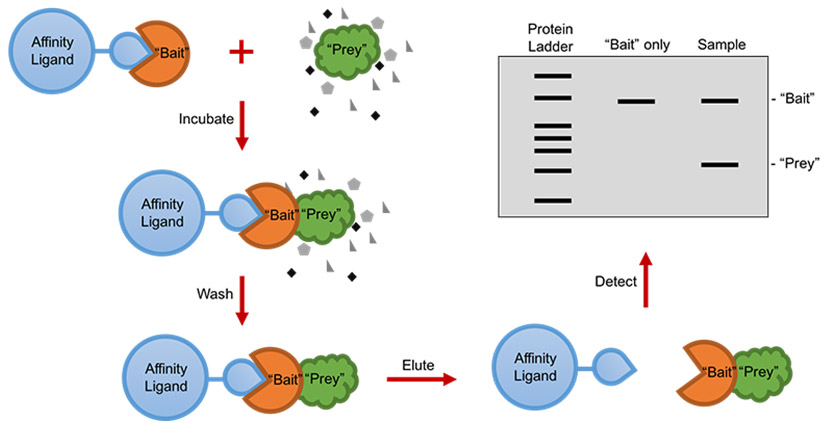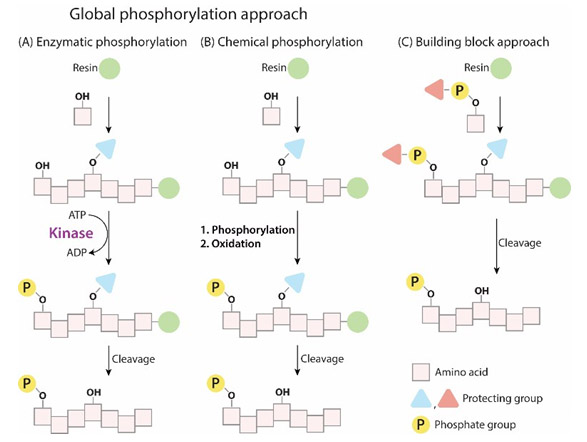400-998-5282
专注多肽 服务科研
400-998-5282
专注多肽 服务科研

编号:166001
CAS号:
单字母:Biotinyl-TRDIYETD-pTyr-YRK-OH

生物素可以与亲和素或者链霉亲和素有力结合,结合强度甚至接近共价键。生物素标记的肽通常用于免疫测定,组织细胞化学和基于荧光的流式细胞术。标记的抗生物素抗体也可以用来结合生物素化多肽。生物素标记常连接在赖氨酸侧链或者N末端。通常在多肽和生物素之间使用6-氨基己酸作为纽带,纽带能够灵活结合底物,并且在有空间位阻的情况下能结合地更好。专肽生物根据需求,向客户提供具有不同位点生物素标记多肽的定制合成。

专肽生物合成用于蛋白质-蛋白质相互作用研究的生物素化肽。尽管生物素可以在 N 端或 C 端引入(通过赖氨酸残基),但我们建议使用 N 端修饰,因为它成本低、成功率高、周转时间短且易于操作。因为多肽合成是从 C 端到 N 端合成的,因此,N 端修饰是 SPPS步骤的最后一步,不需要额外的特定缩合步骤。相比之下,C 端修饰需要额外的步骤,并且通常更复杂。当然,原则上生物素可以定位在任何地方。

生物素可以通过多种不同的接头或间隔物与肽分离。尽管如此,还是建议包含一个灵活的间隔物,例如 Ahx(一个 6 碳接头),以使生物素标签更加稳定或灵活。
专肽生物在 N 端或 C 端提供生物素化:生物素-N 端、赖氨酸-生物素-肽中间和赖氨酸-生物素-C 端。
专肽生物还可以使用 Ahx 接头或长碳 (LC) 接头提供生物素化:生物素-Ahx-N 末端、Lys-Ahx-生物素-肽中间、Lys-Ahx-生物素-C-末端。

(生物素结构)
示例:
GRGDS在N端和C端标记生物素的结构展示。
1、GRGDS在N端标记生物素,不增加Ahx 接头

2、GRGDS在N端标记生物素,增加一个Ahx 接头

3、GRGDS在C端标记生物素,不增加Ahx 接头

4、GRGDS在C端标记生物素,增加一个Ahx 接头。

磷酸肽的合成
在生命过程中发挥重要作用,磷酸化的位置在多肽上的Tyr、Ser,Thr,。目前磷酸肽合成一般都采用磷酸化氨基酸,目前使用的都是单苄基磷酸化氨基酸。磷酸化氨基酸的连接一般采用HBTU/HOBt/DIEA方法,但是目前采用该方法合成磷酸化多肽也有缺点,特别是在合成多磷酸化多肽或氨基酸较长的多肽的时候,连接效率低,最后产品纯度很低,对于这种磷酸化多肽,我们考虑采用后磷酸化方法,其合成过程就是在多肽合成结束后,选择性脱去要标记的氨基酸的侧链保护基,对于Tyr,Thr可以直接使用侧链不保护的氨基酸进行反应,而Ser可以采用Fmoc-Ser(trt),在1% TFA/DCM条件下可以定量的脱除。后磷酸化,采用双苄基亚磷酰胺,四氮唑生成亚磷酰胺四唑活性中间体,连接到羟基上,随后在过氧酸下氧化生成磷酰基,完成反应。
目前,多肽的磷酸化修饰方法主要有两种:
(1)将适当保护的磷酸化氨基酸直接引入到多肽序列中;
(2)多肽序列在树脂上合成完后,再对其中的Ser、Tyr或Thr的侧链羟基进行磷酸化。
1)将适当保护的磷酸化氨基酸直接引入到多肽序列中:
即事先将需要磷酸化的氨基酸(Thr,Ser或Tyr)磷酸化并适当保护,然后按照正常SPPS 合成流程将磷酸化单体缩合到多肽指定位点。这种方法操作简便,已经成为多肽单位点 磷酸化修饰的主要方法。

2)多肽序列在树脂上合成完后,再对其中的Ser、Tyr或Thr的侧链羟基进行磷酸化:
采用将磷酸化单体缩合到多肽中的方法进行磷酸化修饰时,磷酸化的氨基酸由于侧链修 饰的较大基团产生的位阻而导致难以与肽链缩合,并且之后的氨基酸引入都会比较困难, 尤其在含有多个磷酸化位点修饰时,合成将变得异常困难,并且最终产物成分复杂,难 以分离,产率极低。
因此,当肽链中多个位点进行磷酸化时,可以考虑采用将多肽序列 在树脂上合成完后,再对其中的Ser、Tyr或Thr的侧链羟基进行磷酸化:其合成过程主要 就是在多肽合成结束之后,选择性的脱去要标记氨基酸的侧链保护基,对于Tyr,Thr可 以直接使用侧链不保护的氨基酸进行反应。
侧链保护基在1%TFA/DCM条件下可以定量的脱 除。采用这种方法时,可以采用双苄基亚磷酰胺,四氮唑生成亚磷酰胺四唑活性中间体, 连接到羟基上,然后在过氧酸条件下氧化生成磷酰基,完成反应。
磷酸肽的的介绍
在所有的PTM中,磷酸化是最丰富和最重要的修饰之一。磷酸基团是一个高度带负电的分子,在磷原子周围有一个四面体结构。磷酸化多肽主要指肽链中的Ser、Tyr和Thr 残基的侧链羟基被修饰成酸式磷酸酯多肽。许多激素均是通过提高丝氨酸(Ser)或苏氨酸(Thr)残基的磷酸化状态来调节特异性酶的活性。磷酸化与人类疾病高度相关。例如,tau、α-synuclein和huntingtin的过度/多重磷酸化与人类疾病高度相关,聚集磷酸化也爆发神经退行性疾病的主要原因之一,例如阿尔茨海默氏病、帕金森氏病和亨廷顿氏病。目前,对磷酸化氨基酸的主要研究集中在羟基磷酸单酯型磷酸化氨基酸(O-磷酸化氨基酸),即磷酸化丝氨酸,磷酸化苏氨酸,磷酸化酪氨酸。

专肽生物生物为客户提供pSer、pTyr、pThr和D-pSer、D-pTyr、D-pThr的磷酸化修饰服务,也可以进行二、三、四、五个磷酸化位点修饰的高质量多肽的合成。
多肽Biotin-Thr-Arg-Asp-Ile-Tyr-Glu-Thr-Asp-Tyr(PO3H2)-Tyr-Arg-Lys-COOH的合成步骤:
1、合成CTC树脂:称取2.3g CTC Resin(如初始取代度约为0.48mmol/g)和1.32mmol Fmoc-Lys(Boc)-OH于反应器中,加入适量DCM溶解氨基酸(需要注意,此时CTC树脂体积会增大好几倍,避免DCM溶液过少),再加入3.31mmol DIPEA(Mw:129.1,d:0.740g/ml),反应2-3小时后,可不抽滤溶液,直接加入1ml的HPLC级甲醇,封端半小时。依次用DMF洗涤2次,甲醇洗涤1次,DCM洗涤一次,甲醇洗涤一次,DCM洗涤一次,DMF洗涤2次(这里使用甲醇和DCM交替洗涤,是为了更好地去除其他溶质,有利于后续反应)。得到 Fmoc-Lys(Boc)-CTC Resin。结构图如下:

2、脱Fmoc:加3倍树脂体积的20%Pip/DMF溶液,鼓氮气30分钟,然后2倍树脂体积的DMF 洗涤5次。得到 H2N-Lys(Boc)-CTC Resin 。(此步骤脱除Fmoc基团,茚三酮检测为蓝色,Pip为哌啶)。结构图如下:

3、缩合:取3.31mmol Fmoc-Arg(Pbf)-OH 氨基酸,加入到上述树脂里,加适当DMF溶解氨基酸,再依次加入6.62mmol DIPEA,3.15mmol HBTU。反应30分钟后,取小样洗涤,茚三酮检测为无色。用2倍树脂体积的DMF 洗涤3次树脂。(洗涤树脂,去掉残留溶剂,为下一步反应做准备)。得到Fmoc-Arg(Pbf)-Lys(Boc)-CTC Resin。氨基酸:DIPEA:HBTU:树脂=3:6:2.85:1(摩尔比)。结构图如下:

4、依次循环步骤二、步骤三,依次得到
H2N-Arg(Pbf)-Lys(Boc)-CTC Resin
Fmoc-Tyr(tBu)-Arg(Pbf)-Lys(Boc)-CTC Resin
H2N-Tyr(tBu)-Arg(Pbf)-Lys(Boc)-CTC Resin
Fmoc-Tyr(HPO3Bzl)-Tyr(tBu)-Arg(Pbf)-Lys(Boc)-CTC Resin
H2N-Tyr(HPO3Bzl)-Tyr(tBu)-Arg(Pbf)-Lys(Boc)-CTC Resin
Fmoc-Asp(OtBu)-Tyr(HPO3Bzl)-Tyr(tBu)-Arg(Pbf)-Lys(Boc)-CTC Resin
H2N-Asp(OtBu)-Tyr(HPO3Bzl)-Tyr(tBu)-Arg(Pbf)-Lys(Boc)-CTC Resin
Fmoc-Thr(tBu)-Asp(OtBu)-Tyr(HPO3Bzl)-Tyr(tBu)-Arg(Pbf)-Lys(Boc)-CTC Resin
H2N-Thr(tBu)-Asp(OtBu)-Tyr(HPO3Bzl)-Tyr(tBu)-Arg(Pbf)-Lys(Boc)-CTC Resin
Fmoc-Glu(OtBu)-Thr(tBu)-Asp(OtBu)-Tyr(HPO3Bzl)-Tyr(tBu)-Arg(Pbf)-Lys(Boc)-CTC Resin
H2N-Glu(OtBu)-Thr(tBu)-Asp(OtBu)-Tyr(HPO3Bzl)-Tyr(tBu)-Arg(Pbf)-Lys(Boc)-CTC Resin
Fmoc-Tyr(tBu)-Glu(OtBu)-Thr(tBu)-Asp(OtBu)-Tyr(HPO3Bzl)-Tyr(tBu)-Arg(Pbf)-Lys(Boc)-CTC Resin
H2N-Tyr(tBu)-Glu(OtBu)-Thr(tBu)-Asp(OtBu)-Tyr(HPO3Bzl)-Tyr(tBu)-Arg(Pbf)-Lys(Boc)-CTC Resin
Fmoc-Ile-Tyr(tBu)-Glu(OtBu)-Thr(tBu)-Asp(OtBu)-Tyr(HPO3Bzl)-Tyr(tBu)-Arg(Pbf)-Lys(Boc)-CTC Resin
H2N-Ile-Tyr(tBu)-Glu(OtBu)-Thr(tBu)-Asp(OtBu)-Tyr(HPO3Bzl)-Tyr(tBu)-Arg(Pbf)-Lys(Boc)-CTC Resin
Fmoc-Asp(OtBu)-Ile-Tyr(tBu)-Glu(OtBu)-Thr(tBu)-Asp(OtBu)-Tyr(HPO3Bzl)-Tyr(tBu)-Arg(Pbf)-Lys(Boc)-CTC Resin
H2N-Asp(OtBu)-Ile-Tyr(tBu)-Glu(OtBu)-Thr(tBu)-Asp(OtBu)-Tyr(HPO3Bzl)-Tyr(tBu)-Arg(Pbf)-Lys(Boc)-CTC Resin
Fmoc-Arg(Pbf)-Asp(OtBu)-Ile-Tyr(tBu)-Glu(OtBu)-Thr(tBu)-Asp(OtBu)-Tyr(HPO3Bzl)-Tyr(tBu)-Arg(Pbf)-Lys(Boc)-CTC Resin
H2N-Arg(Pbf)-Asp(OtBu)-Ile-Tyr(tBu)-Glu(OtBu)-Thr(tBu)-Asp(OtBu)-Tyr(HPO3Bzl)-Tyr(tBu)-Arg(Pbf)-Lys(Boc)-CTC Resin
Fmoc-Thr(tBu)-Arg(Pbf)-Asp(OtBu)-Ile-Tyr(tBu)-Glu(OtBu)-Thr(tBu)-Asp(OtBu)-Tyr(HPO3Bzl)-Tyr(tBu)-Arg(Pbf)-Lys(Boc)-CTC Resin
以上中间结构,均可在专肽生物多肽计算器-多肽结构计算器中,一键画出。
最后再经过步骤二得到 H2N-Thr(tBu)-Arg(Pbf)-Asp(OtBu)-Ile-Tyr(tBu)-Glu(OtBu)-Thr(tBu)-Asp(OtBu)-Tyr(HPO3Bzl)-Tyr(tBu)-Arg(Pbf)-Lys(Boc)-CTC Resin,结构如下:

5、生物素反应连接:在上述树脂中,加入适当DMF后,再加入3.31mmol 生物素到树脂中,再加入6.62mmol DIPEA、3.15mmol HBTU,鼓氮气反应30分钟。用2倍树脂体积的DMF 洗涤3次树脂(洗涤树脂,去掉残留溶剂,为下一步反应做准备)。 得到Biotin-Thr(tBu)-Arg(Pbf)-Asp(OtBu)-Ile-Tyr(tBu)-Glu(OtBu)-Thr(tBu)-Asp(OtBu)-Tyr(HPO3Bzl)-Tyr(tBu)-Arg(Pbf)-Lys(Boc)-CTCResin。 结构如下:

6、切割:6倍树脂体积的切割液(或每1g树脂加8ml左右的切割液),摇床摇晃 2小时,过滤掉树脂,用冰无水乙醚沉淀滤液,并用冰无水乙醚洗涤沉淀物3次,最后将沉淀物放真空干燥釜中,常温干燥24小试,得到粗品Biotin-Thr-Arg-Asp-Ile-Tyr-Glu-Thr-Asp-Tyr(PO3H2)-Tyr-Arg-Lys-COOH。结构图见产品结构图。
切割液选择:1)TFA:H2O=95%:5%
2)TFA:H2O:TIS=95%:2.5%:2.5%
3)三氟乙酸:茴香硫醚:1,2-乙二硫醇:苯酚:水=87.5%:5%:2.5%:2.5%:2.5%
(前两种适合没有容易氧化的氨基酸,例如Trp、Cys、Met。第三种适合几乎所有的序列。)
6、纯化冻干:使用液相色谱纯化,收集目标峰液体,进行冻干,获得蓬松的粉末状固体多肽。不过这时要取小样复测下纯度 是否目标纯度。
7、最后总结:
杭州专肽生物技术有限公司(ALLPEPTIDE https://www.allpeptide.com)主营定制多肽合成业务,提供各类长肽,短肽,环肽,提供各类修饰肽,如:荧光标记修饰(CY3、CY5、CY5.5、CY7、FAM、FITC、Rhodamine B、TAMRA等),功能基团修饰肽(叠氮、炔基、DBCO、DOTA、NOTA等),同位素标记肽(N15、C13),订书肽(Stapled Peptide),脂肪酸修饰肽(Pal、Myr、Ste),磷酸化修饰肽(P-Ser、P-Thr、P-Tyr),环肽(酰胺键环肽、一对或者多对二硫键环),生物素标记肽,PEG修饰肽,甲基化修饰肽等。
以上所有内容,为专肽生物原创内容,请勿发布到其他网站上。





